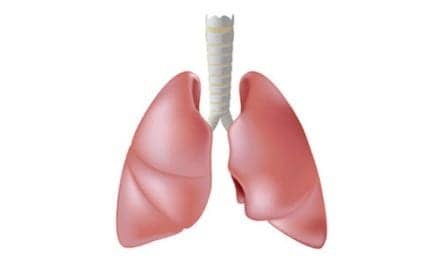A former Sputum Bowl champ reflects on the “good bowl days” as he prepares to bid farewell to the yearly competition.
For the past 20 years, the American Association for Respiratory Care (AARC)
has sponsored a national
competition fondly known to those in the respiratory care profession as The Sputum Bowl. The Bowl involves teams from more than 35 states who compete for 2 days until only four are left. These teams meet on Monday night for the finals competition and an evening of entertainment, often attended by up to 3,000 spectators. For the past 17 years, Keith Hopper, MA, RRT, a three-time Bowl champ, has been a fixture at the yearly competition, where he has served as one of the moderators. With tough
questions, snappy banter, and impeccable timing that has often had the audience and team members on the edge of their seats, Keith has come to epitomize the best of the Sputum Bowl tradition. His retirement this year marks the end of an era. We can only thank him for his fine example and bid him a fond farewell
as the torch is passed on.
Best wishes, Keith.
James B. Fink, MS, RCP, RRT
Edward Hines, Jr, VA Hospital, Hines, Ill
It was 1978, and I had been a registered respiratory therapist for 2 years. Many current practitioners were still toddlers. When I look at pictures from that time, I gasp at how young I look. I must have been 12. And how thin. I wore bell-bottom jeans, listened to disco music in the Boise night spots, and watched people do the Bump. Travolta ruled. I rode a big Honda, and was considered to be a likely organ donor. It was a time before Reagan, before the Ayatollah, before HIV. I remember reading a magazine article about a tiny company named Apple that was marketing a personal computer you had to assemble yourself. I also heard about something new and intriguing going on in nearby Utah, something with a charming name–the Sputum Bowl.
Humble beginnings
That year a small group of Boise therapists entered the regional Sputum Bowl in Denver. An engineer from Boise State University built us a set of buzzers (still in use) for practice. In Denver, we were introduced to a dynamic young man named Ron Koncher, inventor and coordinator of the event. My team was frightened, lost the first game, managed to tie with a protest, then narrowly won. We were on to the first national Sputum Bowl in Las Vegas. We never lost or tied again. People asked us why our team did so well, and the reasons were so simple they disappointed even us. We were from Idaho, and we expected to be trounced at the nationals by teams from bigger places, so we studied and practiced hard. We were hoping to avoid a major humiliation. Also, what else was there to do in Boise in 1978 besides practice Sputum Bowl questions–and the Bump, of course.
Teri Norell was our secret weapon. She had the fastest trigger finger in the West, and had a knack for hitting the buzzer at the exact moment the moderator uttered the last critical syllable of the question, making a correct guess possible. Tom Gable has a lot of credibility in his voice, and we got quite a few points for wrong answers just because the moderators weren’t up to taking him on. (I’ve known Tom for a quarter century and even I can’t always tell when he’s snowing me.)
After 3 years of winning, the AARC Sputum Bowl Committee invoked what is now known as the Idaho Rule: you have to sit out a year after you win. My team had retired anyway, but I guess they wanted to make sure we wouldn’t be back. It wasn’t the last they would see of me, however. The Sputum Bowl had grown exponentially, so I pointed out that a second moderator was needed and, of course, that it should be me. I was at the right place at the right time, and one of the few people on the planet with Sputum Bowl experience. Plus, I had a pair of sensible shoes.
Looking Back
It is now 1998, and as I click away on a laptop that has more computing power than all of MIT had just 2 decades ago, I feel a lump form in my throat as I consider these are the last Sputum Bowl questions I will write. I and Tom Gable, my best friend, have published three volumes of questions. We wrote banks of questions for state competitions, for the nationals–I guess about 10,000 in all by now. Some questions from 1978 are still heard at national Sputum Bowls today. “What is the alveolar surface area in the adult?” “How many milliliters of oxygen can combine with
1 gram of hemoglobin?” “What is Avogadro’s law?”
It is difficult for me to read anything today in respiratory care without automatically forming a potential question. I consider the refinement of question processing to be my unique contribution to the Sputum Bowl. During the first few years, editing was done mostly during the game. The moderator would flamboyantly toss bad questions–and there were a lot of them–into the air and a big pile would build up as the games went on. It struck me as profoundly unfair that poor grammar should be a factor in an event at this professional level.
There were many more protests then, mostly because of poor question construction. It was not unusual to hear the same question many times during a national bowl and sometimes even twice during a single game. In 1986, we introduced computer-based processing and stringent methods of question grooming. This eventually became Tom Gable’s major responsibility, and he did it with precision and care (he is retiring from the Bowl this year as well). The overall caliber of today’s questions is light-years beyond that of the early bowls. It has been years since a question used in game play was found to be grossly in error or incorrectly referenced, and this is entirely because of Tom’s meticulous preparation and management. Tom culls out questions likely to draw a protest, verifies every reference, and rewrites them for grammar and consistency. The questions are carefully selected, ordered, and monitored during the bowl, and Tom can predict the number of questions required in 2 full days of competition to within a handful. There is a consistent rhythm to every game, and this is no accident. Nor is the fact that the questions tend to become more difficult as the Bowl progresses; this is controlled with mathematical precision.
There were games in the early bowls during which we could see we were going to completely run out of questions. We simply recycled stacks of cards from earlier games, turned them upside down, and reworded the answer into a question. No one noticed.
Fond Memories
There are many reasons I will miss the Sputum Bowl, but the following are among the strongest:
Most of all, I will miss working with my friends. Ultimately, that was what being part of the Sputum Bowl was about for me.
Among my fondest memories are:
Unofficial Awards
The following is my unofficial “best of”‘ list:
Best team nobody knows or will ever know. There is talk about having a bowl for championship teams, but it wouldn’t settle anything. Teams are only in their prime once (ask the teams who tried for a second win)! True, we won three times, but this was the exception, not the rule. Once you sit out for a year, you lose your edge, and in 1978, the year we were champs, there were only four teams. Today there are as many as 36. Also, there were teams who played superbly, probably better than anyone, but inconsistently. Consistency is clearly a factor in winning at nationals. Many excellent teams failed to ever reach the finals.
Best game. The best games actually occur in the last few rounds of semifinals. The teams are warmed up, there are no stage lights in their faces, the crowd isn’t overwhelming, and the teams spare nothing. You rarely see just how good these people are in finals. Forced to choose one best finals game, I would select the 1996 championship game between Colorado and Idaho.
Best manners. Probably Bruce Bray of the early Georgia team. Nobody had really thought much about sportsmanship until he came along.
Most tenacity. Bob Lamb from the Ohio team. No question. I hold him and the North Carolina basketball coach (“Never quit! Never quit!”) up to my students as role models of tenacity.
Sputum Bowl’s biggest fans. Bill Galvin and Mimi Bartell. Bill’s always there to straighten your tie, pat you on the back, or laugh at your jokes. He runs the scoreboard, runs errands, and polishes our speeches but never asks for the limelight. Mimi’s unflappability and dry wit have helped Sputum Bowl over some rough stretches. She’s Texas sweet but there is also a toughness to her.
Conclusion
I have confidence that in 20 years I’ll still be able to watch a national Sputum Bowl and remember what an amazing experience it was for me. I think it says something about the national organization that it has the imagination and grit to implement and maintain something this unique. I think Sputum Bowl is emblematic of the very best in the field of respiratory care: imagination, innovation, tenacity, a sense of humility, and a sense of humor. It will be painful next year when I know there is a national Sputum Bowl and I won’t be there.
Keith Hopper, MA, RRT, is general manager of MedSoft Rainier, Savannah, Ga, and a doctoral candidate in instructional technology at Georgia State University.









